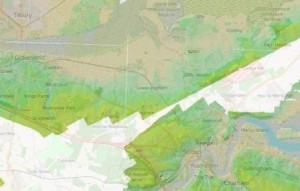Although I lived in Shorne from 1956 to 1987 my memories are more related to my teenage years when I was a member of the Air Cadets and later an apprentice carpenter.
In 1956 I bought two plots of land, next to Gothic Cottages on Shorne Ridgeway, for £200.00 each. I built a chalet bungalow and named it ‘CRECA’, on one plot and sold the other. I later moved to ‘Homemead’, 10 The Street and lived there until I moved in 1987.
Air Cadets
My first memories of Shorne are from when I was an air cadet when I was 15, in 1943. We spent the summer weekends and holidays living in the chalk pit in Thong Lane. We went down into it by the stairs that had been cut into the chalk; at the bottom were three tunnels that we lived in. We had to cycle to Ashenbabnk RAF camp three times a day for our meals, which we had in their canteen.
Our main duty for this time was to keep the aircraft clean and free from oil and grease after they had returned to the airfield. I remember on one occasion that a Typhoon’s radiator had straw and grass around it’s radiator that we had to clean it out. The airfield was quite busy with planes coming in for re-fuelling and servicing.
I had my first flight in an aircraft during this time, one day one of the pilots asked us if we would like a flight, being young lads we all shot our hands in the air. He couldn’t take us all but four of us went up in an Airspeed Oxford, which was used for pilot training, two sitting and two standing. We were too excited to be scared; there was no regard for health and safety in those days.
Another thing that we did was plane spotting, we went into the control tower and looked for planes through our binoculars (they weren’t our own binoculars, they belonged to the RAF). We had to identify the planes as they came in, to make sure that they were ours!
One of the most exciting things was that we were invited to go and watch films taken from the aircraft while they were in action, shooting other planes or dropping bombs.
There was a concrete pill box on the opposite side of the road that was manned by the RAF; although I never saw or heard any guns being fired. There was no real threat from the air by 1943 when we were there, I never heard a bomb drop or saw any dog fights during that summer.
There was a V1 that landed in Cheney’s Farm in Thong Lane, luckily it wasn’t a built up area and the only real damage was to two Oast Houses on the farm.
Most of the farms in the area that had flat open spaces had railway track fixed end on in the ground, with steel wire strung between them, that was to stop enemy gliders attempting to land. There must have been a shortage of railway track available as there were also old cars parked, that served the same purpose.
I remember seeing several radio masts in Shorne Woods but I think these must have been dismantled and taken away by the military when the war ended.
Apprentice carpenter
Later in the war I was an apprentice carpenter and helped repair Woodlands House in Woodlands Lane, Shorne. It had been very badly damaged by a V1 that had landed on an army hut on a piece of land behind the houses. There were blankets and all sorts of other debris in the surrounding trees. It was converted into five or six flats by the council, to help with the housing shortage but it was so badly damaged that after the war it was pulled down and another house built in its place.
Unfortunately I don’t have many memories of Shorne Woods from my time on The Ridgeway as I was mainly working or building my house and didn’t really go into the woods.
Cobham Hunt used to meet at Boghurst Cottage, which were two cottages with a room between where the hunt met.
Anderson’s wood yard was on a triangular piece of land opposite Sandpit cottages. One of the things they made was wooden fencing so were probably buying coppiced wood from Lord Darnley.
I don’t really have any memories of the clay works in Shorne Woods except for the wash mill where the clay was slurried and pumped along the A2 to the Tollgate (Northumberland Bottom); from there it was pumped to Bevan’s cement works at Northfleet.
Mandi Knight (Alan’s, daughter)
From about 1973 to 1979 we used to go into the woods to go swimming in the larger of the two lakes, we didn’t go into the smaller one as there was still some of the conveyor belt; that had been used during the clay extraction, in the lake; these are now the fishing lakes in the park.
There wasn’t much vegetation in the area; it had all been lost when the clay was extracted. Now though,you wouldn’t know that the clay extraction had taken place.
We used to climb over the piles of overburden that had been dumped by the lakes, it was very loose and gypsum crystals would be uncovered and we would pretend that we had found diamonds. I think that I may still have some of them hidden away somewhere.
*As told to Trevor Bent (a member of the Shorne Woods Heritage Group) in April 2015.




